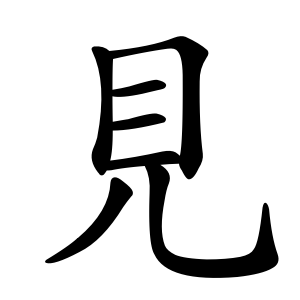見
- to see, to view, to look;
- to behold, to pay respects;
Etymology
Usage in Korean
Generally means "to see" or "to look," but it has a broader range of meanings.
When placed before a verb, it can indicate that the action is directed toward the speaker (e.g., 請見諒 means "Please forgive me," where the request is directed to the speaker).
Conversely, the character 相 is used to indicate actions directed toward the listener.
Nouns preceding 見 or 相 are usually interpreted as objects (empty words).
It also means "to appear" or "to be visible" (an intransitive use), read as "현."
For example, the phrase 見龍在田 ("a dragon appears in the field") from the I Ching.
Additional notes
In Chinese, the character 看 is more commonly used for the meaning "to see," while 見 is often used in the sense of "to meet."
Derived characters
Characters with 見
11 strokes
24 strokes
見
볼
견
bol
gyeon
Kangxi radical:147
Strokes:7
Unicode:U+898B
Cangjie input:
- 月山竹山 (BUHU)
Composition:
- ⿱ 目 儿
